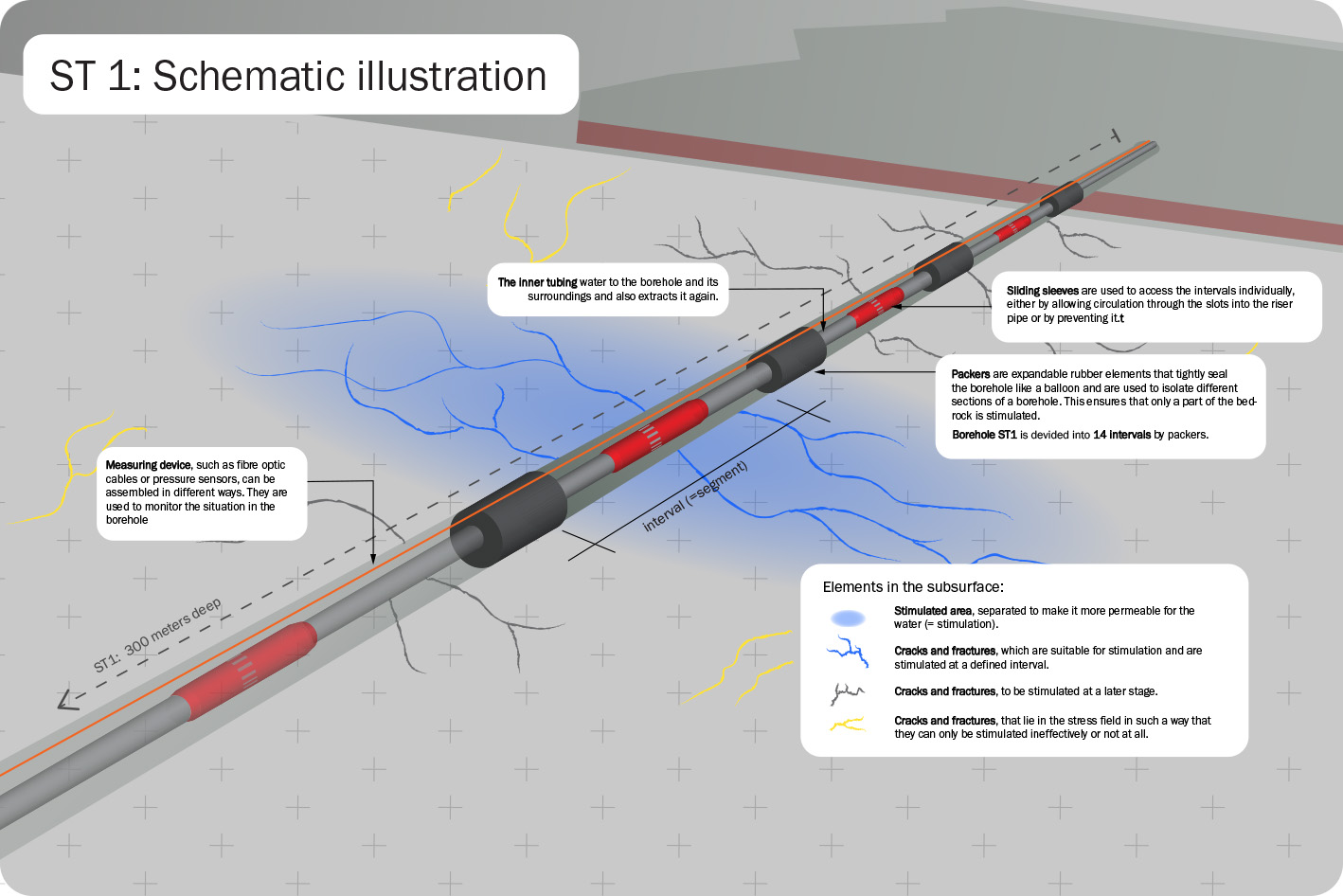2022-05-11
First phase of VALTER stimulations completed successfully

With a series of small- to moderate-scale injections in the anticipated VALTER reservoir, key physical properties of the host rock have been investigated. The experiments led to a comprehensive data set, which is currently being analysed by the VALTER Team. The results will form the basis for the next phase of the project, in which a proxy of a geothermal reservoir will be created.
Since February 2022, the multidisciplinary VALTER Team, including roughly 15 researchers as well as engineers and technicians of various backgrounds, worked on a tight schedule to carry out the first suite of multi-stage stimulations of the VALTER project. This stimulation concept is a unique approach, in which a borehole is divided by packers into several segments that can be stimulated separately. Following this methodology, which has been developed and tested at some intervals in the BedrettoLab by Geoenergie Suisse within the Destress project, specific fracture systems can be targeted and characterized in more detail. Additionally, multi-stage stimulations may minimise the level of induced seismicity.
Hydrotests and stimulations
The stimulations were carried out in borehole ST1 (s. image) and set up to obtain more insights on the fractured rock mass and its transmissivity. From the 14 intervals within ST1, nine intervals were probed (the remaining five intervals were stimulated earlier in the framework of Destress). The tests included initial hydrotests, followed by the actual stimulations and another hydrotest after the completion of the stimulations. During the stimulations, water was injected in a controlled fashion into a specific interval, and the resulting pressure, temperature and deformation changes, as well as induced seismicity, were monitored with a dense network of sensors.
Seismicity wanted
Besides acquiring hydraulic and hydromechanical data, a real time-monitoring of the seismicity is essential for such experiments, because the injected water is not only flowing through pre-existing fractures but also creates new fractures of various sizes that then help to enhance the reservoir transmissivity. The latter is required for creating a reservoir and therewith the exploitation of geothermal energy. This process is also associated with induced seismicity. During the VALTER stimulations, seismic events of moment magnitudes ranging from -6 to -3 occurred. These earthquakes are way too small to be felt and can only be measured by very sensitive instruments. However, this seismicity is an essential diagnostic tool during the reservoir creation process, and such small events are thus welcome. In order to avoid earthquakes of larger magnitudes that could be felt or put anyone into danger, a so-called traffic light system has been put into place. When predefined thresholds would be reached and detected by the monitoring system, ongoing procedures would immediately be put on halt. During this first phase of VALTER, none of the experiments triggered events that would have required any change of the injections.
Data analyzation and preparation
First data analyses are currently underway. Initial results show a large variety of the hydraulic, hydromechanic and seismic behaviour of the rock mass volume during the stimulations. For example, some intervals exhibit strong seismic response but little hydraulic changes, whereas other intervals show the opposite. The VALTER team is currently establishing conceptual models that are compatible with all these observations. These models will be of great importance for the next phase of the VALTER project, in which a proxy of a geothermal reservoir should be generated. Here, the most promising structures will be stimulated with larger injections that may extend over longer periods.
A multidisciplinary effort
The complexity of the experimental setup and the multidisciplinary nature of the VALTER project required substantial coordination efforts. Efficient communication between the individual research disciplines and with the technical staff proved to be essential. Here, the project benefitted from the excellent infrastructure in the BedrettoLab. The entire monitoring network is connected to a fast internet connection. This enabled seamless interactions between the onsite team and the various experts located at ETH Zurich. The individual data streams could be checked in real time, and, when necessary, decisions on adjustments of the procedures could be taken very quickly.
The Bedretto Reservoir Project
The currently running VALTER project is part of the Bedretto Reservoir Project, which is an umbrella project for VALTER, Destress and ZoDrEx. While having the complementary targets, the three projects test and develop different techniques for the creation of a test reservoir. In this context, VALTER and Destress investigate the enhancement of the stimulation processes. Thereby, DESTRESS mainly focused on the proof of concept of the multi-stage stimulations whereas VALTER is monitoring the processes in the rock more densely and over a longer period of time. ZoDrEx focuses on the improvement of drilling efficiency, zonal isolation technologies and development of instrumentation for geothermal energy plants.

